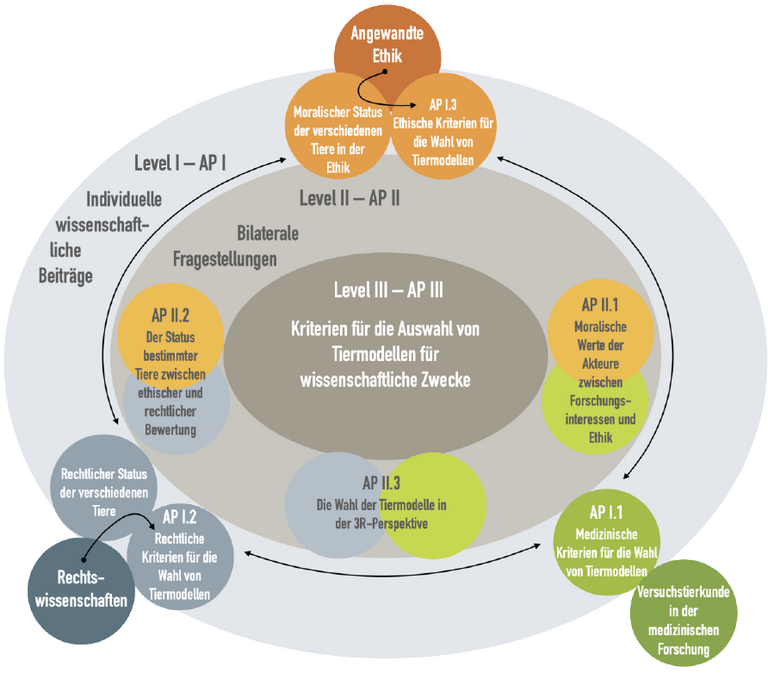BMBF-Project: AniMotion
Animal Models - Selection Criteria in Ethical and Legal Perspective
AniMotion is a BMBF-funded, interdisciplinary project in co-operation between the University of Bonn and the coordinator TiHo Hannover. The project encompasses the fields of ethics and philosophy (Prof. Dr Peter Kunzmann, TiHo), laboratory animal science (Prof. Dr Bernhard Hiebl, TiHo), infection research (Prof. Dr Maren von Köckritz-Blickwede, TiHo) and law (Prof. Dr Dr Tade Spranger, University of Bonn).
AniMotion approaches the question with a fully interdisciplinary concept that not only combines the scientific competences, but also interweaves them on a total of three levels. On the first level, the respective perspective on the choice of model animals is first clarified with the respective subject-specific criteria. On a second level, questions are addressed that require two scientific competences each (e.g. the relevance of the 3Rs principle between law and laboratory animal science; the question of the subjective burden for the actors between ethics and research practice). The aim is to arrive at a catalogue of criteria on the third level that is coherent from all perspectives.
Public discourse is largely dominated by the question of the legitimacy of animal experiments in general. Questions about the "details" of specific experimental projects are discussed less frequently, although the real conflicts are sparked precisely by the conditions of specific projects. In view of the large number of laboratory animals, it is legitimate and even necessary to ask not only whether we (allow) experiments to be carried out, but which experiments they are.
One of the important and often controversial questions in such discussions is: Which animals are used for which experiments?
Researchers, authorities, legislators and ethicists have their own ideas about how these choices should be made and (ideally) on what principles they should be based. The question arises as to how consistently this selection is made from the perspective of the individual stakeholders and how scientific, legal and ethical arguments can be brought together to form a coherent picture for decision-making. The project should lead to a concept that summarises different technical approaches while retaining their respective merits and at the same time combining them into a model that is suitable for forming the basis for a kind of rational consensus.
Publications (selection)
- Meurer, Persson, Hasenau, Gläsersohn, Spranger, Messer, Hartstang, Hiebl, Kunzmann, v. Köckritz-Blickwede: How to choose the right animal species for a scientific experiment – An example of a decision tree including scientific, ethical and legal perspectives. (submitted to LabAnimals).
- Persson, Perez, Hartstang, Kunzmann, Hiebl, Shaw (2025): What and why is the “evolutionary scale” in Swiss Animal Welfare Law? Putting the Platypus in its Place. LEOH-Journal of Animal Law, Ethics and One Health, 60-73.
- Hasenau: Doctoral Thesis on the German legal framework, EU Directive 2010/63 (in press).
- Hasenau: Schwein gehabt? – Das Hausschwein als ein rechtlicher Hybrid, in: Natur und Recht 2024, p. 246-249.
- Hasenau: Tiere für die Tonne, in: Neue Zeitschrift für Verwaltungsrecht 2024, 1055.
- Hasenau: EU-weites Pelzverbot - Geht es Pelzmänteln bald an den Kragen?, NuR 2025, (in press).
- Hasenau: Mit fremden Federn geschmückt: "Ohne Kükentöten" - Werbung mit einer Selbstverständlichkeit, GRUR 2024, 1859.
- Hasenau: Insekten in Lebensmitteln: Trash or Treat, ZLR 2024, 519.
- Hasenau: Das Verbrennen von Nutztieren: Ein Muss in der EU, bestattungskultur 2024, 58.
- Hasenau, Persson, Messer, Hartstang: Das Konstrukt der Unerlässlichkeit im Rechtsrahmen zum Tierversuch. Anmerkungen aus rechtlicher und aus ethischer Perspektive. (in press)
- Persson, Hartstang: QUALY as a supporting factor for animal model selection in animal research. (EurSafe 2024).
- Messer, Persson, Hartstang, Kunzmann: Zu den Grenzen der Pathozentrik als Entscheidungskriterium für die Wahl des Tiermodells im Tierversuch. (in press)
- Persson, Perez, Louis-Maerten, Müller, Shaw: “Killing in the Name of 3R?” The Ethics of Death in Animal Research.” In: Journal of agricultural and environmental ethics 38, no. 1 (2025): 1-18.
- Perez, Shaw, Earp, Elger, Persson: “One R or the other – an experimental bioethics approach to 3R dilemmas in animal research.” In: Medicine, Health Care and Philosophy 27, no. 4 (2024): 497-512.
- Perez, Müller, Persson, Shaw: “Simply the best? How the ranking argument prevents improvements in animal welfare law in the EU.” In: EurSafe2024 Proceedings, pp. 179-186. Wageningen Academic, 2024.